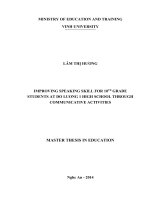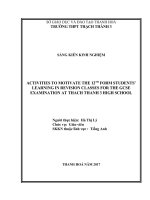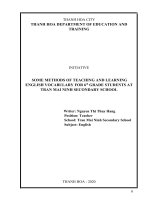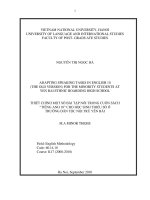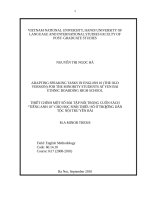skkn cấp tỉnh improving english vocabulary for the 12thgrade students at thach thanh 1 high school by using mind mapping techniques
Bạn đang xem bản rút gọn của tài liệu. Xem và tải ngay bản đầy đủ của tài liệu tại đây (505.27 KB, 24 trang )
<span class="text_page_counter">Trang 1</span><div class="page_container" data-page="1">
THANH HOA EDUCATION AND TRAINING DEPARTMENT
<b> THACH THANH I SENIOR HIGH SCHOOL</b>
<b> EXPERIENTIAL INITIATIVE</b>
<b>GRADE STUDENTS AT THACH THANH 1 HIGH SCHOOLBY USING MIND-MAPPING TECHNIQUES</b>
<b>Author: Trịnh Thị MaiOccupation: Teacher</b>
<b>Experiential initiative on: English</b>
THANH HÓA - NĂM 2024
</div><span class="text_page_counter">Trang 2</span><div class="page_container" data-page="2"><b>TABLE OF CONTENTS</b>
2.3. Solutions to the problems 9
2.4. Effectiveness of using mind-mapping techniques 12
2.5. Sample lessons 17
<b>3. CONCLUSION AND PETITION </b> 20
<b>REFERENCES</b>
</div><span class="text_page_counter">Trang 3</span><div class="page_container" data-page="3"><b>1. INTRODUCTION </b>
<b>1.1. Reasons for choosing the topic.</b>
The last few decades have witnessed massive changes in the demand ofthe English language. It is the greatest contribution to people’s success not onlyin academics but also in daily life. In Vietnam, English plays an extremely vitalrole both in global communication and the desire for mankind’s knowledge. Tomeet the demands of the society, English teachers continually strive to employnew methods and techniques in teaching the language. In acquiring a foreignlanguage, vocabulary plays a crucial part, continually strive to employ newmethods and techniques in teaching the language. Speaking on the importanceof vocabulary, Wilkins (1972) noted that: "without grammar little can beconveyed, without vocabulary nothing can be conveyed." Indeed, people need touse words to express themselves in any language. To effectively communicate ina foreign language, one must possess an adequate amount of vocabulary andknow how to use it correctly.
Moreover, based on my experience as an English teacher, I have observedthat my students often struggle to speak English fluently. They find speakingand writing activities (productive skills) tiresome because they tend to reuse thesame words and expressions, resulting in abrupt pauses in their conversationsdue to a lack of vocabulary. Consequently, their receptive skills (listening andreading) are not good eitherThe primary cause of such issues is the lack ofvocabulary. Other students are faced with the problem of forgetting the wordsright after the teacher has elicited their meaning or after having looked them inthe dictionary. This also contributes to the problem of vocabulary shortage.
Recognizing the importance of vocabulary, I myself understand that theteacher has an essential role in helping students to improve their vocabulary.
<i><b>Therefore, I have decided to conduct a study named “IMPROVING</b></i>
<b>ENGLISH VOCABULARY FOR THE 12<small>th </small>GRADE STUDENTS ATTHACH THANH 1 HIGH SCHOOL BY USING MIND-MAPPING</b>
<b>1.2. Research purpose and objectives</b>
The aim of the study is to enhance the English vocabulary of 12th-gradestudents at Thach Thanh 1 High School. In order to achieve the purpose, thestudy is expected to accomplish the following objectives:
- Exploring the attitudes of 12th-grade students towards the use of mapping techniques in vocabulary teaching.
mind-- Evaluating the effectiveness of mindmind--mapping technique applied to vocabularyteaching.
<b>1.3. Research questions</b>
The objectives of the study can be formulated into the research questionsas follows:
</div><span class="text_page_counter">Trang 4</span><div class="page_container" data-page="4"><i>- How is mind-mapping technique used in vocabulary teaching assessed by the12<small>th</small> graders at Thach Thanh 1 High School? </i>
- What is the effectiveness of the mind-mapping technique on the Englishvocabulary outcomes of 12th-grade students at Thach Thanh 1 High School?
<b>1.4. Scope of the research </b>
The focus of the study is using mind-mapping technique to improve the 12<small>th</small>
graders’ English vocabulary at Thach Thanh 1 high School. Therefore, the studycannot cover every aspect in vocabulary teaching. It specifically concentrates onemploying mind mapping as a technique to improve vocabulary among 12th-grade students at Thach Thanh 1 High School.
The study participants consist of 80 male and female students from classes12A2 and 12A6. The age of those 90 students ranges from 17 to 18. They aregoing to be the participants and respondents to survey questionnaires, triallessons and tests.
The action plan was implemented in 5 months from October 2023 toFebruary 2024, during the academic school year (2023-2024) at Thach Thanh 1High School.
<b>1.5. Research methodology</b>
The purpose of this study is to find out whether mind-mapping techniquehas any positive impact on improving and retaining the vocabulary of 12th-grade students and to explore students' attitudes toward this technique.Additionally, as the researcher,I aim to enhance my students' learning skills andmy own professional effectiveness. Therefore, I hope this will be a practicalaction research project as its purpose is to examine a specific school situationwith a view to improving practice, focusing narrowly on a specific problem, andbeing conducted by an individual teacher in a high school.
In order to address the two research questions, both qualitative andquantitative methods are utilized in this action research. The data are collectedvia survey questionnaires, interviews and tests.
<b>2. CONTENTS</b>
<b>2.1. Theoretical background2.1.1. Vocabulary Defined </b>
According to Webster (1994), vocabulary is a list of words commonlyused in every aspect of life and words are usually arranged alphabetically withan equivalent definition. To elaborate further, vocabulary is often explained ortranslated, depending on the word stock at the command of an individual for theuse of this person in particular work, language, or branch of subject, etc.Additionally, Lado (1994) defines vocabulary as a form of expression related tothe meaning and content of words. Meanwhile, Scrivener (1994) also definesvocabulary as a powerful means of conveying meaning because when a student
</div><span class="text_page_counter">Trang 5</span><div class="page_container" data-page="5">recognizes the importance of vocabulary in communication and learning, theymay have a rational intention to obtain, receive, and accept knowledge about alarge amount of vocabulary.
In summary, there are many different points of view about vocabulary.Having mentioned these definitions, the researcher decided to use Webster's(1994) definition in this study because this scholar's definition is moreappropriate and useful for use in the research.
<b>2.1.2. Vocabulary Classified </b>
According to Scrivener (1974), vocabulary can be divided into two types,including productive (active vocabulary) and receptive (passive vocabulary). ,Hendrich (1988, p. 131) states that, vocabulary classification can be maintainedfrom various viewpoints: formal (for example word classes); mechanical(according to the frequency); semantic, that is according to the relationships oflanguage marking to off-language reality or according to the relationships ofmeaning (synonyms, antonyms, etcetera); or according to grammaticalperspective, mainly pattern-based, i.e., groups of words together based on thesame grammatical feature.
Another classification by Judy K. Montgomery (excerpted from the book:"The Bridge of Vocabulary: Evidence Based Activities for Academic Success"by NCS Pearson Inc, 2007) includes 4 types of vocabulary:
- Listening, which are words we hear and understand.- Speaking, which are words we use when speaking.
- Reading, which are words we understand when reading texts.
- Writing, which are words we can retrieve when writing to expressourselves.
The first two types constitute spoken vocabulary and the latter two arewritten vocabulary. Children begin to acquire listening and speaking vocabularymany years before they start building reading and writing vocabulary. Orallanguage forms the foundation for written language. Each type serves a differentpurpose, and fortunately, the development of vocabulary in one type willfacilitate the development in another.
<b>2.1.3. Vocabulary Tests Defined </b>
There are many exercises published on vocabulary. Each of them can beinterpreted in detail as follows:
<small>•</small> Matching pictures with words can help children demonstrate theirknowledge. Activities like these can also be vocabulary lessons, wherechildren match local bird species, providing an opportunity for themtodemonstrate their knowledge in the names and sounds of the birds.
<small>•</small> Matching parts of words with other parts that children are using theirdeveloping memory for, utilizing their storage, organization, and retrievalabilities, recalling informationin relation to something they have seen before.
</div><span class="text_page_counter">Trang 6</span><div class="page_container" data-page="6"><small>•</small> Matching words with other words, such as synonyms, antonyms, groupingrelated words, etc., can also provide children with opportunities to furthertheir knowledge and then demonstrate that knowledge in aparticular/specialized area of interest.
<small>•</small> Using prefixes and suffixes to construct a new word helps children improvetheir reading comprehension, encountering unfamiliar words. It also helpschildren speak or write concisely. They just add a prefix or suffix andeliminate the extra prepositions or sentences needed to convey the meaning. <small>•</small> Using given words to complete a specific task helps the children practicememory and analytical skills and make the most appropriate choices.
<small>•</small> Filling in crossword puzzles, grids, or charts requires children to look at thealphabetical sequence of a word, helping them learn new writing. Memorygames bring about a wide range of benefits which include:
- Improving concentration abilities.- Training visual memory.
- Enhancing short-term memory.- Strengthening attention to detail.
- Improving the ability to find similarities and differences between objects.- Assisting in categorizing objects based on similar characteristics.
<b>2.1.4. Mind-mapping Technique.Mind-mapping Technique Defined </b>
There are many different views on the definition of mind-mapping. It isdefined by Tony, a British psychologist that “Mind-mapping technique” or“Mind-mapping” was created and made progress in the late 1960s in an attemptto assist learners to do the note-taking more effectively. According to Buzan(1993) in the book “The Mind- Mapping Book”, “Mind-mapping is a powerfulgraphic technique, which provides a universal key to unlocking the potential ofthe brain”. Additionally, it was also noted by McGriff (2000) about Mind-mapping that “Mind-mapping is an excellent way to help learners organizeknowledge, to empower themselves to better comprehend the key concepts andprinciples in lectures, readings or other instructional materials”. Mind-mappingis also defined by Readon and Nourie (1999) that “Mind-mapping is a creativenote-taking method, which eases us to remember much information. Because ofits visual specialty, Mind-mapping is often full of color, pictures, and symbolslike a small art.
</div><span class="text_page_counter">Trang 7</span><div class="page_container" data-page="7"><i><b> Figure 1: An example of Mind-mapping (by Paul Foreman)</b></i>
In general, Mind-mapping illustrates the process of forming ideas happensin our mind. By using Mind-mapping, a great amount of information can bepresented by pictures, lines, colors or symbols. Furthermore, other componentsof a Mind-mapping such as arrows, shapes will help our brain to rememberinformation in a better way.
</div><span class="text_page_counter">Trang 8</span><div class="page_container" data-page="8"><i><b>Figure 2: An example of a network tree (by Karla Šturm)</b></i>
<i><b>Event Chain </b></i>
In general, an event chain is a diagram that serves to illustrate therelationships between events and how they influence each other. Specifically, itssequence describes the progression of procedures of this event.
<i><b>Figure 3: An example of an event chain (by Lori Edwards)</b></i>
<i><b>Cycle Concept Map </b></i>
Cycle concept map could be considered a remarkable type of event chainmap. In this type of map, there is no final outcome produced after the eventsequence. Instead, the last stage in the map has a reversal effect back to theinitial one.
</div><span class="text_page_counter">Trang 9</span><div class="page_container" data-page="9"><i><b>Figure 4: An example of a cycle concept map (by Wayne Sullivan) </b></i>
<i><b>Spider Concept Map </b></i>
This is the most popular and favorite type of Mind-mapping, and it is stillwidely used by many students worldwide to help them study moreeffectively.Svantesson (2004) noted that there are several ways to create mindmaps using this method, specifically the hayfork, thorn fish, cluster, or variationmethods, which are illustrated with examples below:
<i><b>Figure 5: An example of hayfork Figure 7: An example of cluster</b></i>
<i><b><small>Figure 8: An example of variationFigure 6: An example of thorn </small></b></i>
<b><small>fish</small></b>
</div><span class="text_page_counter">Trang 10</span><div class="page_container" data-page="10"><b>2.1.5. Mind-mapping Technique in teaching and learningvocabulary</b>
It cannot be denied that memory plays a crucial role in language learning,memorization, and acquisition, especially in vocabulary acquisition, wherestudents are responsible for familiarizing themselves with and understandingthe pronunciation and meanings of words for effective usage. In order toachieving the aim of learning vocabulary efficiently, taking the advantage of thetool of Mind-mapping, which use personal connection with a view to makingthe process of remembering new information to be more easily and visualizingthe thinking process, a helpful method. As a result, Mind-mapping is consideredto be a highlysupportive teaching technique for mastering the vocabulary of aforeign language.
Clearly, when a word appears in a student's mind, it is often accompaniedby images, visuals, ideas, or relevant associations of that word, and the verynature of these connections is also advantageous in mind mapping. Leaners cantake advantage of it to use in their learning. Additionally, Mind-mapping can bevery useful in learning writing, which is considered to be the hardest skill for thestudents to learn because of the word limitation and the lack of ideas to expressin a writing task. With the use of mind mapping, students can have a creativeway to brainstorm and form ideas for assignments. Moreover, students canexpress their viewpoints by looking at colorful images, visuals, or words andtransform these perspectives into sentences in their writing. Lastly but not least,mind mapping can be used as a reminder tool for speaking exercises. Studentscan prepare a mind map on the topic they will learn in the lesson. Keywords andclues appearing on the mind map will serve as prompts for them to speak morenaturally, fluently, and confidently.
<b>2.1.6. Advantages of using Mind-mapping Technique </b>
As outlined in previous sections, the first reason for the advent of Mindmapping was to make the note-taking action of learners, or regularly the actionof writing words down with lots of words, which has three followingdisadvantages: writing down redundant words is time-consuming and labor-consuming, missing information during the process of writing and taking moretime to read and review, to be more effective (Tony, 2004).
On the other hand, applying the Mind Mapping technique has manystrengths. According to De Porter and Hernacki (2008), there are four mainadvantages and three disadvantages when applying the Mind Mapping techniquein the classroom, as mentioned below.
<small>•</small> Flexibility
The Mind-mapping can help students express their ideas in a very flexibleway, because details or information can be added easily to the Mind-mapping,basing on our viewpoints, anywhere in the Mind-mapping.
<small>•</small> Topic’s concentration
</div><span class="text_page_counter">Trang 11</span><div class="page_container" data-page="11">Because of the special position in the Mind-mapping, the topic, which isoften written in biggest and most colorful letters or pictures, can be seen by thestudents easily and it helps students focus on what he or she is mentioning ortalking about.
<small>•</small> Increasing in comprehension
It is proven that using Mind-mapping can make the process ofunderstanding the materials more easily, because Mind-mapping is a simplepattern with branches in different directions and obviously it does not create theconfusion when students learn the materials.
<small>•</small> Enjoyment
Imagination, beauty, words, ideas or creativity is unlimited, and it makesMind-mapping to be interesting and exciting to make. The use of picture, imageand colors also makes the brain feeling comfortable and it will stimulate theappearance of ideas and information.
<b>2.2. Practical background</b>
The English Group consists of 6 graduate teachers with bachelor's degreesfrom various universities in Vietnam. The teachers at Thach Thanh 1 have acooperative spirit and are enthusiastic about teaching. Most students prefernatural science subjects (such as Math, Physics, Chemistry) over English.Despite the importance of English at this school and its status as a compulsorysubject for all students, they only perceive English as a foreign language.Therefore, as an English teacher, I encounter difficulties in teaching skills suchas reading, listening, speaking, and writing, especially in teaching vocabulary tomy students. Specifically, my students often find learning vocabulary tedious(although some are proficient in grammar). They express that vocabulary isdifficult to remember because they do not change their study habits, such aswriting words on paper, attempting rote memorization, or passively learningthrough teacher explanations.
This study is conducted at Thach Thanh 1High School, Thanh HoaProvince. The textbook used for 12th-grade students is “Tiếng Anh 12”,published by Vietnam Education Publishing House.
Students at Thach Thanh 1 High School, especially those in theexperimental classes, do not have the similar competence of English. Teachersoften face students who are weak in vocabulary skills.
Therefore, this research aims to find ways to improve vocabulary skills inlearning English using the Mind Mapping technique and propose some effectivesolutions.
<b>2.3. Solutions to the problems</b>
This study was conducted using a two-stage sampling method,implemented through cluster sampling and individual sampling. It cannot bedenied that there will be two groups selected through the classroom, where class12A2 will be the Experimental group and class 12A6 will be the Control group.
</div><span class="text_page_counter">Trang 12</span><div class="page_container" data-page="12">After gathering and dividing students into two groups based on their classes, theresearcher assessed individual sampling capability by administering a pre-test tostudents from both groups as previously tested; the sampling of the study ispresented in the table below.
<b>THE SAMPLE OF THE STUDY</b>
<b>No.Group`<sup>Number of</sup><sub>students</sub><sup>Number of matched</sup><sub>pairs</sub></b>
<b>2.3.1. Participants: Researcher and Students</b>
The author of this study is also a teacher, an intervenor. She is a teacherwith 18 years of experience and has been teaching the 12<small>th</small>-grade students formore than 10 years. Therefore, she understands the students' situation well andwants to find ways to help them learn English, especially vocabulary, moreeffectively.
Additionally, the participants in this research are 80 students from classes12A2 and 12A6 at Thach Thanh 1 High School in the academic year 2023 -2024. They are in their final year of high school and striving for admission touniversities. They will participate in the GCSE (General Certificate ofSecondary Education) exam, the most important exam, at the end of theacademic year. The researcher hopes that after participating in this study,students can find ways to improve their vocabulary, which could greatly benefitthem in the English exam of the GCSE, further academic pursuits, and theirfuture lives.
<b>2.3.2. Research Methods used for this study: Action Research</b>
To conduct this study, the author will select students from both classes12A2 and 12A6; then divide the selected students into two groups; which areexperimental and control group. After the vocabulary test experimentationprocess ends, the author will administer the same test to students from bothgroups. Then, a thirty-minute vocabulary lesson with mind mapping and mindmapping techniques will be delivered to the experimental group, while a lessonwithout mind mapping will be delivered to the control group. Finally,immediately after the lesson, both groups will take a post-test, and another testthree weeks later. Data will be collected, processed, and analyzed through thesetests.
In this study, there are two types of variables that can be used, includingindependent variables and dependent variables. The independent variable is themind mapping technique provided to students, and the dependent variable is thestudents' scores in the vocabulary tests.
</div>

